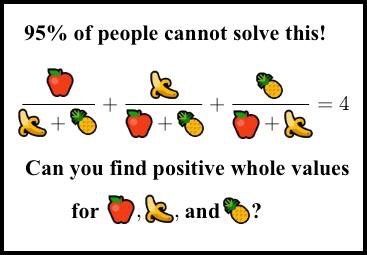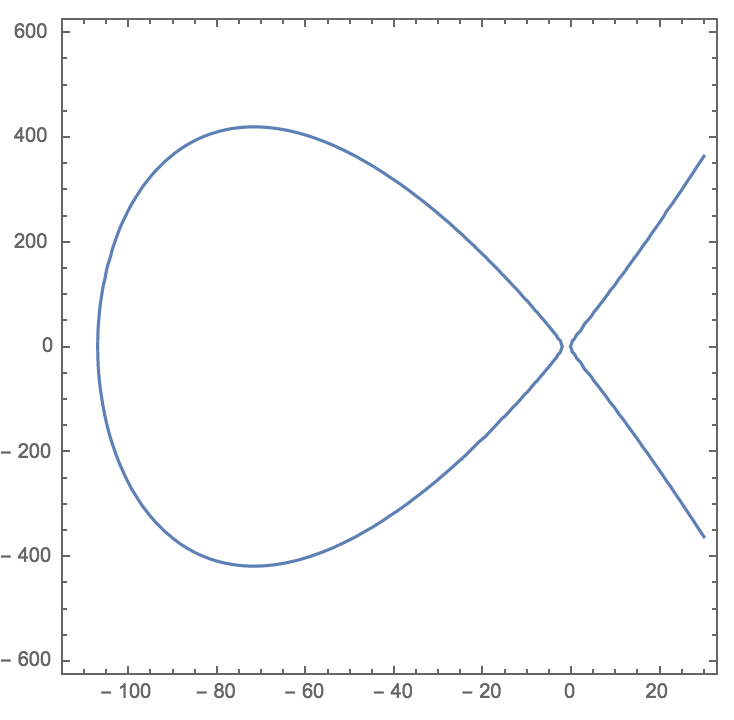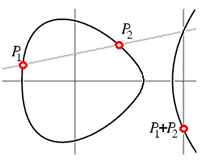Math Detective: Finding Positive Whole Solutions to an Equation
“I experimented with the tasks of the cubic representation in the style of the previous work of Andrew and Richard Guy. The numerical results were amazing ... "( comment on MathOverflow)This is how the retired mathematician Allan MacLeod came across this equation a few years ago. And it is really very interesting. Honestly, this is one of the best Diophantine equations I have ever seen, but I haven't seen very many of them.
I found it when it began to spread as a picture-pseudomem disengaging into the network of nerds, invented by someone’s ruthless mind ( Sridhar , was it you?). I did not immediately understand what it is. The picture looked like this:

“95% of people will not solve this riddle. Can you find positive integer values? ”
')
You probably already saw similar pictures memes. It is always the cleanest rubbish, clickbates: “95% of MTI graduates will not solve it!”. “She” is some kind of stupid or poorly worded problem, or a trivial warm-up for the brain.
But this picture is completely different . This meme is a clever or evil joke. Approximately 99.999995% of people do not have the slightest chance to solve it, including a good part of mathematicians from leading universities who are not engaged in number theory. Yes, it can be solved, but it is really difficult. (By the way, Sridhar did not invent it, or rather, he didn’t fully. See the story in this commentary ).
You might think that if nothing else helps, then you can simply get the computer to solve it. It is very easy to write a computer program to find solutions to this seemingly simple equation. Of course, the computer sooner or later will find them, if they exist. Big mistake . Here, the simple computer search method will be useless.
I do not know whether it will be possible to fit the complete solution into the article, if one does not accept that everyone already knows everything that is necessary about elliptic curves. I can only give a brief overview here. The main reference source is the wonderful, relatively recent work of Bremner and MacLeod entitled “An unusual cubic representation problem” , published in 2014 in Annales Mathematicae et Informaticae .
So let's get started.
We are looking for positive integer solutions of the equation
f r a c a b + c + f r a c b a + c + f r a c c a + b = 4 t a g 1
(I replaced the variable notation with those used in the work).
The first thing to do when investigating any equation is to try to place it in the right context. The question must be asked: what is this equation? So, we are asked to find integer solutions, that is, this is the problem of the theory of numbers. In the current formulation, rational functions are used in the equation (polynomials divisible by other polynomials), but it is obvious that we can multiply by a common multiple of the denominators to clean up the equation and get only polynomials, that is, to bring it to the form of Diophantine equations . The requirement of "positivity" is rather unusual, and, as we shall see, complicates everything.
So, how many variables do we have here? The question seems silly: it is obvious that three, namely a , b and c . But do not rush. An experienced number theory researcher will instantly notice that the equation is homogeneous . This means that if ( a , b , c ) is one of the solutions to the equation, the solution is and ( 7 a , 7 b , 7 c ) . Do you understand why? Multiplying each variable by some constant ( 7 - this is just an example), we will not change anything, because the constant in each of the parts is reduced.
fractatb+tc= fractat(b+c)= fracab+c
This means that the equation only pretends to be three-dimensional. In fact, it is two-dimensional. In the geometric representation, we have a surface (one equation with three variables generally defines a two-dimensional surface. In general, k equations with n variables are set d -dimensional diversity, where d=nk ). But this surface is actually bounded by a line that oscillates and passes through the origin. The resulting surface can be understood by understanding how it cuts a single plane. This is a projective curve.
The easiest way to summarize this information is this: we can divide the decisions, whatever they may be, into those at which c=0 and those for which c neq0 . In the first case, we only have two variables, a and b and in the second we can simply divide by c and get a solution when c=1 . Therefore, we can simply seek rational solutions in a and b for the occasion c=1 multiply them by the common factor and get the integer solution in a , b and c . In essence, the integer solutions of homogeneous equations correspond to rational solutions of a non-uniform version, which is one dimension less.
Let's continue: what is the degree of our equation? The degree of an equation is the maximum degree that any one appearing in a monomial equation, where a “monomial” is a product of several variables, whose “degree” is the number of monomials to be multiplied. For example, a2bc4 will be a monomial degree 7=2+1+4 .
The behavior of Diophantine equations strongly depends on their degree. Generally:
- With degree 1 everything is simple.
- Power 2 fully analyzed and can be solved in rather elementary ways.
- Power 3 - This is a vast ocean of deep theory and a million unsolved problems.
- Power 4 and above ... Very, very complex.
We have a degree 3 . Why? We simply multiply by the dividers:
a(a+b)(a+c)+b(b+a)(b+c)+c(c+a)(c+b)=4(a+b)(a+c)(b+c)
Even without opening the parentheses, you can see that the degree is 3 : we never multiply more than three variables at once. We will have parts like a3 , b2c and abc , but there will never be more than three factors. If you make a transformation, the equation will be
a3+b3+c3−3(a2b+ab2+a2c+ac2+b2c+bc2)−5abc=0
You can argue that multiplication by divisors is impossible if some of them are equal. 0 . This is true - indeed, our new equation has several solutions that do not correspond to the original equation. But actually it is good. The polynomial version adds a few patches to the original and it becomes easier to work with it. We just need to check if the original dividers disappear at each particular solution.
In fact, the equation with polynomials is easy to solve, for example, a=−1 , b=1 , c=0 . This is good: we have a rational solution (a rational point). This means that our cubic equation (degree = 3) is actually an elliptic curve .
When you discover that the equation is an elliptic curve, then a) you rejoice and b) you despair, because there is still a lot to be studied. This equation is a great example of how a powerful theory of elliptic curves can be applied to finding insanely hard-to-define solutions.
The first thing that they usually do is an elliptic curve — they bring it into a Weierstrass form. This is an equation that looks like
y2=x3+ax+b
and sometimes how
y2=x3+ax2+bx+c
(this is called the expanded Weierstrass form. It is optional, but sometimes more convenient).
Usually any elliptic curve can be reduced to this form (unless you are working on fields with small characteristics, but here we do not need to worry about them). It would take too long to explain how to find the right transformation, so just know that this is an absolutely mechanical process (it is critical that there is at least one rational point that we have). There are various computational algebra packages that will do everything for you.
But even if you do not know. how to find a transformation, to test it is very simple, at least it is done purely mechanically. The required transformation in our case is given by scary-looking formulas.
x= frac−28(a+b+2c)6a+6b−c
y= frac364(a−b)6a+6b−c
I know that they look like an unknown voodoo magic from where, but believe me, this is not so. Having obtained these transformations, with the help of monotonous, but rather simple algebraic calculations, we show that
y2=x3+109x2+224x tag2
This equation, although it looks quite different, is in fact a reliable model of the original. Graphically, it looks like this - a typical elliptic curve with two real parts:

The "fish tail" on the right grows "to infinity and beyond." The oval shape on the left is closed and turns out to be quite interesting for us.
Having any solution (x,y) of this equation, we can recover the necessary values a , b , c using equations
a= frac56−x+y56−14x
b= frac56−x−y56−14x
c= frac−28−6x28−7x
(Remember that the triplet (a:b:c) need to be taken projectively - whatever values you get using these equations, you can always multiply them by any constant).
The two mappings we showed, from a , b , c at x , y and vice versa, they show that these two equations are “identical” from the point of view of number theory: rational solutions of one give rational solutions of the other. Technically, this is called birational equivalence , and it is the fundamental concept of algebraic geometry. As we already noted, there may be exception points that are not displayed correctly. These are cases where a+b , a+c or b+c turn out to be equal 0 . This is the usual reckoning in the case of birational equivalence, and it should not cause any disturbances.
Let's take an example.
There is a good rational point on the elliptic curve (2):
x=−100 , y=260 . It may not be so easy to find, but it is very easy to check : just insert these values and you will see that the two halves are the same (I did not select this point randomly, but for now it does not matter). You can just check what values a , b , c she gives us. We get a=2/7 , b=−1/14 , c=11/14 and since we can multiply by a common factor, the results are converted to a=4 , b=−1 , c=11 .
And in fact,
frac4−1+11+ frac−14+11+ frac114−1=4
as you can easily see. This is a simple solution to our original equation in integers, but, alas, not positive integers. This solution is not easy to get out manually, but it’s also easy to get without all this colossus considered here, with a little patience. The difficulty lies in positive solutions.
Now, getting a rational point on an elliptic curve, for example, P=(−100,260) on our curve (2), we can begin to generate others using the chord and tangent techniques discussed in the previous article on Quora.

First, let's add our point P to her by finding the tangent to the curve at the point P and determining where it meets the curve again. The result will be a bit intimidating:
P+P=2P=(8836/25,−950716/125)
and again this new point corresponds to the values a , b , c which is a solution to the original equation
(a,b,c)=(9499,−8784,5165)
This solution is definitely not easy to find manually, but it is still under the power of a computer. However, it is still unpositive.
Not afraid of failures, we continue to calculate 3P=2P+P that can be determined by connecting a straight line P and 2P and finding the third point of intersection with the curve. And again we calculate a , b , c and again the result is nonpositive. The same will happen with 4P and with 5P and so on ... until we stumble upon 9P .
9P=(-66202368404229585264842409883878874707453676645038225/13514400292716288512070907945002943352692578000406921,
58800835157308083307376751727347181330085672850296730351871748713307988700611210/1571068668597978434556364707291896268838086945430031322196754390420280407346469)It is definitely not easy to find, but with the help of our machinery we just need to repeat the simple geometric procedure nine times. Corresponding values a , b , c awesome:
a=154476802108746166441951315019919837485664325669565431700026634898253202035277999,
b=36875131794129999827197811565225474825492979968971970996283137471637224634055579,
c=4373612677928697257861252602371390152816537558161613618621437993378423467772036These are 80-bit numbers! You couldn’t find 80-bit numbers on your computer using simple brute force. It looks incredible, but by inserting these huge numbers into a simple expression a/(b+c)+b/(a+c)+c/(a+b) we really get exactly 4 .
In fact, they are the smallest solutions to a problem. If we continue to add a point to ourselves P , then dividers will simply grow. It is not easy to prove, because there is always a probability of contraction, but the theory of heights for an elliptic curve allows us to show that these astronomical numbers are in fact the simplest solution of the equation.

Let's return to the theory. An elliptic curve over rational values has a rank , which is the number of points necessary to use for the method of chords and tangents and to be sure that we will find all the rational points on the curve sooner or later. Our elliptic curve (2) has rank 1. This means that it has an infinite number of rational points, but all of them are obtained from the only one, which is nothing but our point. P=(−100,260) . The algorithms for calculating the rank and finding such a generator are far from trivial, but SageMath (now called CoCalc) performs them in less than a second in just a few lines of code. My code can be found here . It reproduces the entire solution from scratch, but, of course, uses the built-in Sage methods for working with elliptic curves.
In our case, the point P lies on the oval part of the curve, like the point mP for any positive integer m . They “swirl” around the oval and are gradually evenly distributed over it. This is very successful, because only a small part of this oval gives positive decisions regarding a , b , c : This is the bold portion of the graph below taken from the work of Bremner and MacLoud.

Points P , 2P , and so on, do not lie on the selected part, but 9P - lies, that's how we got our 80-bit positive solutions.
Bremner and MacLeod studied what happens if we replace 4 something else. If you think that the solutions will be big, then wait until you see what the solutions will be when the result 178 . Instead of 80 discharges, we need 398,605,460 discharges. Yes, this is only the number of digits of the solution. If you replace the result with 896 , the solution will contain trillions of digits. Trillions. For this innocent-looking equation:
a/(b+c)+b/(a+c)+c/(a+b)=896
A striking example of how Diophantine equations with small coefficients can have huge solutions. This inspires not just awe, but a feeling of bottomlessness. The negative solution of the tenth Hilbert problem means that the growth of solutions with increasing coefficients is not a computable function , because if it were computable, then we would have a simple algorithm for solving Diophantine equations, but it does not exist (neither simple nor complex). Conformity 4 to 80-bit numbers 178 to numbers from hundreds of millions of digits and 896 to Trillions of digits gives us a little insight into the first, small steps of this monstrous, noncomputable function. Change the numbers in the equation a bit, and solutions will easily surpass everything that can fit in our miserable, tiny Universe.
Here is a surprisingly tricky little equation.
Thanks to MrShoor for sending me a link to this interesting article.
Source: https://habr.com/ru/post/335248/
All Articles